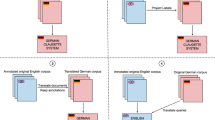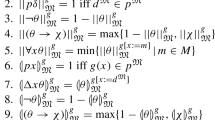Abstract
The analysis of atomic sentences and their subatomic components poses a special problem for proof-theoretic approaches to natural language semantics, as it is far from clear how their semantics could be explained by means of proofs rather than denotations. The paper develops a proof-theoretic semantics for a fragment of English within a type-theoretical formalism that combines subatomic systems for natural deduction [20] with constructive (or Martin-Löf) type theory [8, 9] by stating rules for the formation, introduction, elimination and equality of atomic propositions understood as types (or sets) of subatomic proof-objects. The formalism is extended with dependent types to admit an interpretation of non-atomic sentences. The paper concludes with applications to natural language including internally nested proper names, anaphoric pronouns, simple identity sentences, and intensional transitive verbs.
Similar content being viewed by others
References
Boldini, P., Vagueness and type theory, in C. Retoréd.), Logical Aspects of Computational Linguistics, LNCS 1328, Springer, 1997, pp. 134–148.
Fernando, T., Conservative generalized quantifiers and presupposition, in Proceedings of Semantics and Linguistic Theory XI,Cornell University, 2001, pp. 172–191.
Fernando T.: Situations as strings. Electronic Notes in Theoretical Computer Science 165, 23–36 (2006)
Francez, N., and R. Dyckhoff, Proof-theoretic semantics for a natural language fragment, in C. Ebert, G. Jäger, and J. Michaelis (eds.), Mathematics of Language 10/11,LNAI 6149, Springer, 2010, pp. 56–71.
Francez N., Dyckhoff R.: Proof-theoretic semantics for a natural language fragment. Linguistics and Philosophy 33, 447–477 (2010)
Francez N., Dyckhoff R., Ben-Avi G.: Proof-theoretic semantics for subsentential phrases. Studia Logica 94, 381–401 (2010)
Krahmer, E., and P. Piwek, Presupposition projection as proof construction, in H. Bunt, and R. Muskens (eds.), Computing Meaning,Vol. 1, Kluwer Academic Publishers, 1999, pp. 281–300.
Martin-Löf, P., Intuitionistic Type Theory, Bibliopolis, 1984
Nordström, B., K. Petersson, and J. M. Smith, Programming in Martin-Löf’s Type Theory, Clarendon Press, 1990.
Prawitz, D., Ideas and results in proof theory, in J.E. Fenstad (ed.), Proceedings of the Second Scandinavian Logic Symposium (Oslo 1970), North-Holland, 1971, pp. 235–309.
Prawitz, D., Towards a foundation of a general proof theory, in P. Suppes et al. (eds.), Logic, Methodology, and Philosophy of Science IV, North-Holland, 1973, pp. 225–250.
Prawitz, D., Meaning approached via proofs, Synthese 148:1–12. Special issue on Proof-Theoretic Semantics edited by R. Kahle, and P. Schroeder-Heister, 2006.
Primiero, G., and B. Jespersen, Two kinds of procedural semantics for privative modification, in K. Nakakoji, Y. Murakami, and E.McCready (eds.), New Frontiers in Artificial Intelligence, LNAI 6284, Springer, 2010, pp. 252–271.
Ranta A.: Intuitionistic categorial grammar. Linguistics and Philosophy 14, 203–239 (1991)
Ranta, A., Type-Theoretical Grammar, Clarendon Press, 1994.
Rathjen M.: The constructive Hilbert program and the limits of Martin-Löf Type Theory. Synthese 147, 81–120 (2005)
Sundholm, G., Proof-theory and meaning, in D. M. Gabbay, and F.Guenthner (eds.), Handbook of Philosophical Logic, 2nd Edition, Vol. 9, Kluwer Academic Publishers, 2002, pp. 165–198. (First published in 1984.)
Sundholm G.: Constructive generalized quantifiers. Synthese 79, 1–12 (1989)
Więckowski B. (2010) Associative substitutional semantics and quantified modal logic. Studia Logica 94:105–138
Więckowski B. (2011) Rules for subatomic derivation, The Review of Symbolic Logic 4:219–236
Zimmermann T. E.: On the proper treatment of opacity in certain verbs. Natural Language Semantics 1, 149–179 (1993)
Zimmermann T. E.: Monotonicity in opaque verbs. Linguistics and Philosophy 29, 715–761 (2006)
Author information
Authors and Affiliations
Corresponding author
Rights and permissions
About this article
Cite this article
Więckowski, B. A Constructive Type-Theoretical Formalism for the Interpretation of Subatomically Sensitive Natural Language Constructions. Stud Logica 100, 815–853 (2012). https://doi.org/10.1007/s11225-012-9431-x
Published:
Issue Date:
DOI: https://doi.org/10.1007/s11225-012-9431-x




